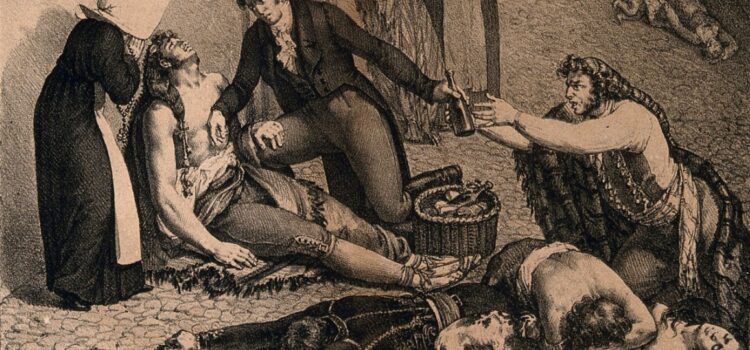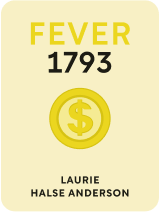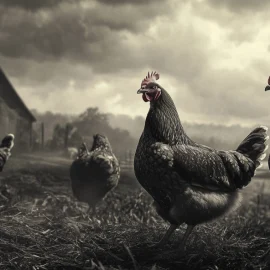

This article is an excerpt from the Shortform book guide to "Fever 1793" by Laurie Halse Anderson. Shortform has the world's best summaries and analyses of books you should be reading.
Like this article? Sign up for a free trial here .
What was Philadelphia like during the yellow fever epidemic? What did Matilda and Grandpa do once they finally got back home?
In the book Fever 1793, Matilda and Grandpa return to Philadelphia after she recovers from yellow fever at Bush Hill. However, the city is not the same as when they left it over two weeks ago.
Continue reading to learn what happened when an outbreak of yellow fever hit Philadelphia.
Yellow Fever in Philadelphia
Sixteen days after leaving for the farm, Matilda and Grandpa left for Philadelphia—yellow fever turned it into a city they would no longer recognize. Bridget stood next to the carriage taking them and five sick children to the orphanage with tears in her eyes. She waved goodbye, and Grandpa waved back, saying he hoped they would meet again when times were better. The carriage moved on, and Bush Hill faded in the distance.
Matilda sat in the back of the carriage next to an older woman named Mrs. Bowles. She was kind and worked at the orphanage. She asked Matilda what her plan was to help, but Matilda didn’t know what there was for her to do. She was just a girl after all. As soon as she said these words, Matilda regretted them. Someone was finally treating her as an adult, and she acted like a baby.
Mrs. Bowles said they needed a lot of help at the orphanage, and a young woman like Matilda could be of great service. Another girl in the carriage, Susannah, was going to the orphanage to do just that. At the orphanage, Matilda would be fed, kept safe, and given a small stipend. But Matilda said no. Her grandpa wouldn’t hear of it and needed her help, too.
Mrs. Bowles understood but cautioned her to stay home once they arrived. The city was dangerous now, with the sick and dead everywhere and men and criminals lurking in the streets. Just then, the carriage rolled through the outskirts of the city. Ceased construction projects left skeletons of new houses and businesses littering the landscape.
When Grandpa learned that there was no food in the city, he suggested writing another letter to the farm to see if they could come stay. But the driver told him mail delivery was no longer in service. Again, Mrs. Bowels offered for Matilda to stay with them, which prompted Matilda to ask what would happen to her and Susannah once the fever was over. Susannah’s parents’ house would be sold, and the money would become her dowry. She would likely work as a scuttle maid or servant until a husband was found.
This was not the fate Matilda imagined for herself. She daydreamed about her mother returning to find the coffeehouse in top shape. She’d marvel at the amazing job Matilda did running it and at the new dry goods store Matilda and Grandpa would open next door. Matilda would accept her accolades wearing a French dress. All would be right again. She’d even hire Susannah to work for them.
Matilda was brought back to reality when they entered the city center. It was daytime, but everything was cast in gray. The stores were closed, and there were no pedestrians on the streets. Houses flew yellow flags to signify the sick inside or had barricaded doors to keep out intruders. A 17-year-old boy in a stained tailored suit lay dead on a stoop. His yellow eyes stared into nothing. His shoes still held their upper-class sheen.
Everywhere she looked, Matilda saw her ravished city. The wagon stopped for a line of men carrying dead bodies in wheelbarrows. A trench was dug next to the central square, and mounds of dirt covered piles of bodies.
When they finally reached the orphanage, Mrs. Bowels and the children exited the carriage. She reminded Matilda of her offer and wished her and Grandpa safety and good health in whatever they decided to do.
Home Sweet Home
Although Grandpa had visited the coffeehouse a few days earlier, everything was different when they arrived. When the carriage pulled up, Matilda noticed the front door cracked. She jumped down and ran up the stairs, hoping to find her mother waiting. Instead, she found the coffeehouse completely ransacked by robbers. Chairs and tables were broken, cookware and crockery smashed on the floor, and the pantry stripped clean. Even the coffee and tea canisters were empty.
The thieves hadn’t gone upstairs, and their rooms were as they left them. At least the strongbox with their money was still hidden below a hollow stair. Grandpa couldn’t believe his eyes. His face grew red, and he held his left arm. Matilda turned on her captain’s voice and ordered him to bed at once. She was also tired, still healing, and needed rest, but someone had to fetch water and find food.
Matilda scoured the dry and brittle garden and managed to find a few beans, some squash, and a few cherries. It wasn’t much, but it was better than nothing. She thanked God for keeping them alive and prayed for her mother and Eliza. She also told God to punish those who’d ruined their home, but not too much. They were probably just hungry, too.

———End of Preview———
Like what you just read? Read the rest of the world's best book summary and analysis of Laurie Halse Anderson's "Fever 1793" at Shortform .
Here's what you'll find in our full Fever 1793 summary :
- What the yellow fever epidemic in 1793 in Philadelphia looked like
- How this epidemic exposed the vulnerability of everyone, including the wealthy
- How an epidemic can impact a young person






